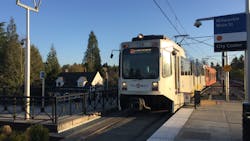The Portland State University's Center for Public Interest Design hosted a competition challenging participants to re-envision the use of TriMet’s oldest MAX light-rail vehicles, which are set to retire in a few years.
While contestants had the freedom to approach their designs from any angle, they were encouraged to find new uses for the trains that could help address homelessness, climate change, racial inequality or other social, environmental or public health crises, including the COVID-19 pandemic. The public can view and vote on the designs at the 2020 Re-purposing Light Rail Cars Design Competition event at the Oregon Rail Heritage Center on Aug. 25.
Competition spurs big ideas
“Wouldn’t it be amazing to find a new way to reuse these old trains that continued the legacy of transit—connecting people with services, with opportunities, with the community we so value,” said TriMet General Manager Doug Kelsey.
The competition grew out of an idea from Kelsey to find a way to re-purpose the Type 1 light-rail vehicles while addressing a public need and, ideally, keeping the trains from becoming scrap.
“It’s time to get creative to the challenges facing our region today,” said Kelsey. “As cities and counties struggle to get people off the streets and into housing, could these vehicles be split up into small apartments, like tiny homes, to help those in transition?”
The competition is designed to get people thinking about new ways to address issues facing the community as well as produce ideas for re-purposing transit vehicles for the public good, although they may not necessarily be applied to TriMet’s retiring trains.
Re-envisioning the oldest MAX trains
The 26 Type 1s were the original trains on the MAX system and have been in service for nearly 34 years. They have stairs at every door and must be paired with other trains to provide ADA accessible MAX service. TriMet will begin to retire these vehicles in 2022 as it begins bringing in the next generation of light-rail vehicles.
Type 1 MAX train
- First year in service: 1986
- Total number of cars: 26
- Interior space: 680-square feet
Designers in the contest had the option to base their designs on the Type 1 trains or Type 2 vehicles. The Type 2s were the first low-floor light-rail vehicles put into use by a transit agency in North America. They’ve been in service since 1997. The Type 2s are being renovated over the next five years, so their retirement date is undetermined.
Type 2 MAX train
- First year in service: 1997
- Total number of cars: 52
- Interior space: 720-square feet
See the designs and meet the winners
Winners of the design competition will be selected during the 2020 Re-purposing Light Rail Cars Design Competition event at the Oregon Rail Heritage Center on Aug. 25, between 4:00 p.m. and 7:00 p.m. The public will have the opportunity to see the designs, meet the creative minds behind them and vote on their favorite for the peoples’ choice award. Space is limited, and those wishing to attend are asked to register in advance. Due to COVID-19, everyone who attends will be required to wear a face covering and encouraged to maintain six feet of physical distance from others. The exhibit will be set up to facilitate one-way traffic for viewing. Design posters and additional information will be posted online for those who are not able to visit the museum in person.



